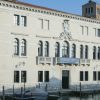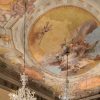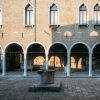The palace was the ancient residence of the bishops of Torcello. It was originally a patrician’s palace in typical Flamboyant Gothic style, and then in 1659 it became the residence of Bishop Marco Giustinian who later bought the property and donated it to the Torcello diocese. This was the period when extensive rebuilding was carried out, based on plans by Antonio Gaspari.
When in 1805 the Torcello diocese was abolished, the palace passed into the hands of the Venice Patriarchate which in turn sold it to the Murano Municipality in 1840, and it became the town hall. When the museum and archives were established in 1861, they were both housed in the central room on the first floor. However, the rapid and steady growth of the collection made it necessary to find more space and so gradually the museum occupied the whole building. After the autonomous Murano Municipality was abolished in 1923 and was\annexed to Venice, the museum became part of the Venice Civic Museums.
Today, the ceiling of the large central room (or portego) on the first floor overlooking thr Grand Canal in Murano testifies the original splendour of the palace with an 18th century fresco by Francesco Zugno (1709 – 1789) depicting the allegory of the Triumph of San Lorenzo Giustinian, the first patriarch of Venice (1381 – 1455), ancestor of the family which radically altered the building in the 17th century. Francesco Zanchi (1734 – 1772) also collaborated with Zugno by completing his work with architectural details. The frieze with the coat of arms of Murano families is modern. Of the three large chandeliers, the central one with 60 branches deserves particular attention.It was made by Giovanni Fuga and Lorenzo Santi and presented at the first Murano Glass Exposition in 1864 where it was awarded a gold medal.



